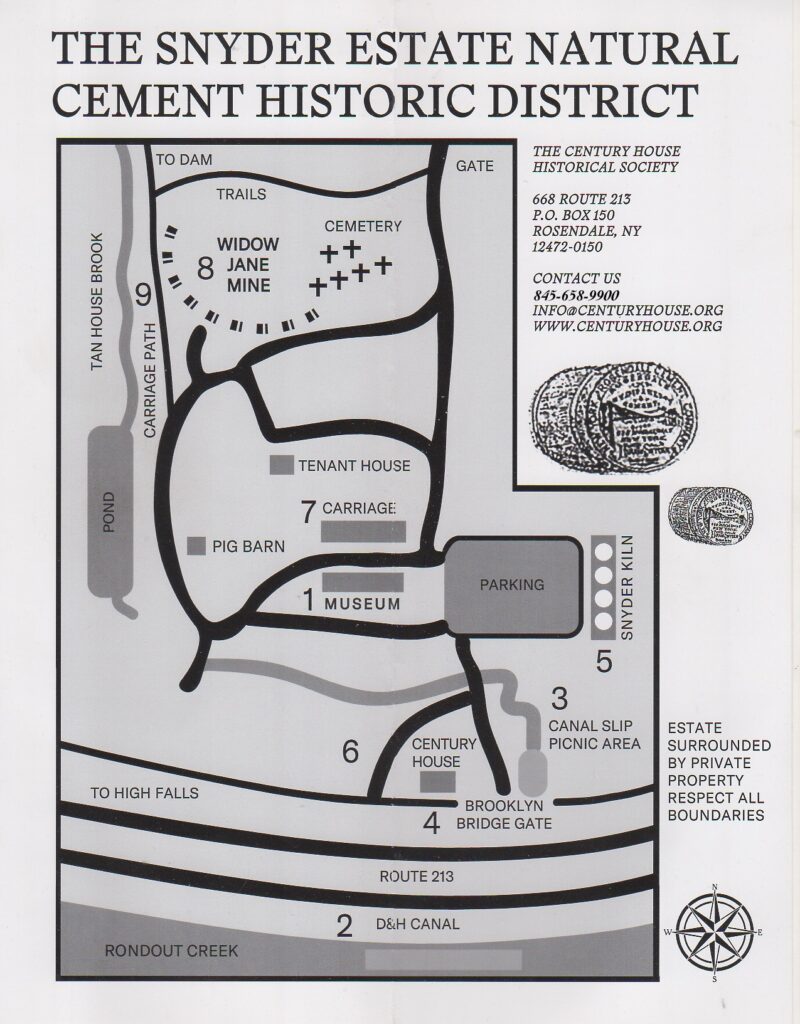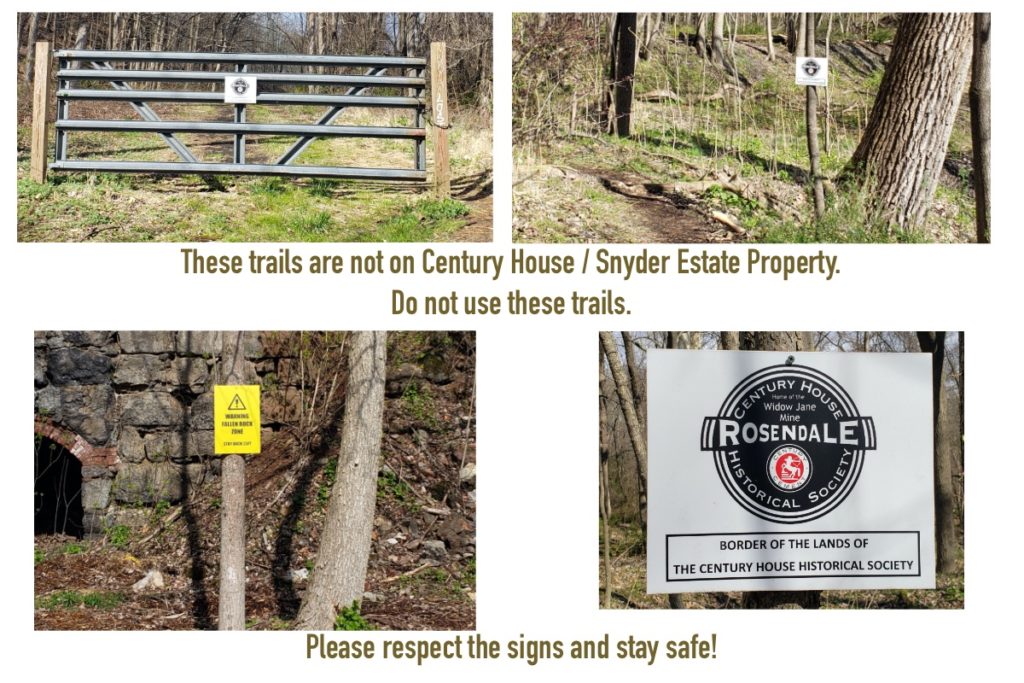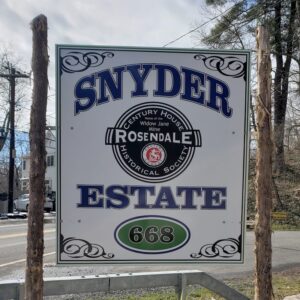Century House maintains a museum on the history of the Snyder Estate, the industrial history of the Rosendale Cement District, and Rosendale history in general.
There is also a large collection of horse carriages and sleighs on view, acquired over the years by the last owner of the Century Cement Manufacturing Company, A.J. Snyder II.
The Society also presents many benefit performances in its unique Widow Jane Mine, and occasionally presents a site specific outdoor sculpture exhibition and site-wide festivals.
Check the EVENTS PAGE for current events!
The Snyder Estate grounds at 668 Route 213 are open for walks and self guided tours from 10AM to 6PM daily during the spring, summer, and early fall, 10AM to 4PM during late fall through early spring. The Estate will be closed in the winter when the Widow Jane Mine freezes over until the Spring when it has definitely thawed.
Free for members – all others, please leave a donation at the donation boxes by the Kiosk, in the museum, or the entrance to the Widow Jane Mine.
Suggested Donation:
- Adults: $5
- Students: $2
- Family: $10
- Or become a member!
There are self-guided tour brochures available at the entrance Kiosk, where you can learn about the history of the Rosendale Cement District, the Widow Jane Mine, and the Snyder Estate.

WELCOME TO ROSENDALE
Strictly observe the no smoking rule in all Estate buildings and woodlands. A restroom is located on the bottom floor of the museum building. Please
place all trash in the dumpster located in the parking lot.
Refer to your map for Estate boundaries. Please respect the
privacy of our neighbors as portions of the neighboring
properties are patrolled.
The information will help you make your visit to the Snyder
Estate and the Rosendale Natural Cement Industry Museum
one of lasting value.
- ROSENDALE NATURAL CEMENT INDUSTRY MUSEUM:
A tribute to all the workers of the cement industry who produced Rosendale Natural Cement covering a period of almost a century and a half. Used in the building of some of the greatest landmarks and structures of our nation. Rosendale Natural Cement is known for endurance and has achieved the highest respect in the industry. Open Sundays 1-4 Mother’s Day (last weekend in May) to Labor Day Weekend (first weekend of September), and by request. - THE DELAWARE AND HUDSON CANAL:
Maurice and William Wurts recognized the need for the anthracite (hard) coal required for growing cities. They surveyed a route that could transport coal from their mines near Honesdale, Pennsylvania to New York City. The canal began operation in 1828 and follows along the other side of Route 213 as it passes the Estate.
In 1836, workmen noticed stone on the Jacob L. Snyder (grandfather of Andrew Snyder I) farm that changed appearance when heated while making their coffee. They brought this rock to a blacksmith shop in High Falls. As they experimented with the rock, an engineer in charge of construction for the canal said that he believed it to be natural cement rock. He was correct. By 1870, the number of cement companies supplying Rosendale Natural Cement to the nation grew to fifteen. Each manufacturer had their own recipe. - SNYDER CANAL SLIP:
A private canal slip which once had a building over the end section, was used to unload the coal used to fire the kilns from the Delaware and Hudson Canal. After processing the cement rock and loading it onto outgoing canal boats, the cement travelled to the Rondout in Kingston and then by barge down the Hudson River to NYC. The slip was originally built for the Snyder’s flour mill around 1825. - BROOKLYN BRIDGE GATES:
Andrew Snyder I was very proud of the fact that the cement used to build the Brooklyn Bridge came from this property. Visitors entering the gates cannot help but be reminded of this fact. Construction of this landmark commenced in 1870. When surveyed in 1936, the towers and abutments were rated as good as they were on the day that the bridge opened. Engineers predicted 500-1000 more years before any repairs would be required. These gates were put up by Andrew Snyder II, his grandson, in the early 1940s.
- SNYDER KILNS:
These are the oldest standing kilns known in Rosendale. One battery of four kilns faces Route 213. These were erected around 1837. The second battery of kilns faces the large parking lot of the estate and was built around 1860 and later. Watson E. Lawrence designed the draw kiln to replace the inefficient batch kiln. This area of
Rosendale is still known as “Lawrenceville”. The kiln was perpetual. Once charged with pea-sized anthracite coal, it was kept in continuous operation. Notice that these kilns are built into the side of the hill so that they could easily be charged from the top. It took four days for the cement rock to travel from the top of the kilns to the floor or “eye” of the kiln where it was cooled before grinding. - CENTURY HOUSE:
The ‘Old Homestead’ of the Snyder family was built in 1809. It was remodeled several times by A.J. Snyder I. The house is now known as the Century House due to the Century Cement Company. It was built by Christopher Snyder for his son Jacob L. Snyder and his wife Catherine Hasbrouck. These were the third generation grandparents of Andrew Snyder I. The style of this house is eclectic in decor and many styles blend together to convey a feeling of affluence and comfort. The Century House remains appointed as when A.J. Snyder I lived there. - CARRIAGE HOUSE & STABLES:
Various styles of carriages dating from 1890-1940 are on display. The building was built into the hillside and provides a perfect environment for the carriages as it allows for the slow changes in temperature necessary to preserve the wood. Many remember A.J. Snyder II driving through the area with his coach dogs at his side. - THE WIDOW JANE QUARRY:
Visitors are asked to admire the beauty of this structure. Workers removed cement rock by blasting and drilling. Pillars of rock left to support the ceiling were called ‘leggos’ by immigrant workers as when it is overmined, rock will “let go.” After mining activity ceased in this mine, it was leased for the growing of mushrooms. This became a use for several of the dormant mines in Rosendale. - THE CARRIAGE PATH:
This path follows the Tan House Brook which fills the pond. Visitors can walk this trail up to the small dam and enjoy the many types of birds and plant life. Remember that no smoking is permitted in the woodlands and visitors are asked to please remain on the trail.
Just a reminder: please respect the Snyder Estate border markings.

The Snyder Estate and Widow Jane Mine are occasionally closed for site maintenance, site rentals, event rehearsals and prep, or other emergencies.
When the Estate and Mine are closed, you can still get a Rosendale Cement Experience by going on a walk up the Wallkill Valley Rail Trail. Find out more about the Wallkill Valley Rail Trail at : https://www.wvrta.org.
- Park at the large lot on Binnewater Road (County Rt. 7). Note the mixture of modern and older kilns at the rear of the lot!
- Enter the rail trail by crossing the road, and turn left and walk north.
- There’ll be an informational kiosk on the trail as you cross Breezy Hill Road, near the Women’s Studio Workshop. This intersection was known as Keator’s Corners, the center of the Binnewater Historic district.
- As you continue northward, you’ll pass by the ruins of the F.O. Norton Cement company, and more informational posters.
- Further up the trail, you’ll pass by more kilns, and eventually, you’ll pass more former cement mines (fenced off and not open to the public).
- Observe the nearly vertical excavation in one of the mines, showing how twisted the seams of dolostone were! You can get the same cool breeze from the mine shafts – on humid, cool days, low lying mists will appear on the trail!
The CHHS also recommends a visit to the related D&H Canal Museum at
1315 Main Street, High Falls, NY 12440 http://canalmuseum.org
Directions to The Snyder Estate
Less than two hours from New York City, Rosendale is midway between New Paltz and Kingston, Exits 18 and 19 of the NYS Thruway (I-87).
From Exit 18 (New Paltz) take NY 32 north to Rosendale.
From Exit 19 (Kingston) take NY 209 south to Stone Ridge, then NY 213 east to Rosendale.
The Snyder Estate is at 668 Route 213, on the north side of Route 213, a mile west of the village.
Route 213 is a winding road as it follows the Rondout Creek. Please use caution when entering and exiting the site. You can only exit to the right, as the curve is extremely blind! There’s a turnaround you can use a little way down the road if you want to go to the main part of Rosendale.
We look forward to your visit!
Nearby Points of Interest
We’re within half an hour of these popular destinations:
D&H Canal Museum In High Falls
Historic Huguenot Street in New Paltz
Historic Kingston in Kingston
Mohonk Preserve in New Paltz
Minnewaska State Park in New Paltz
Senate House Museum in Kingston
Maritime Museum in Kingston
Trolley Museum in Kingson
Wallkill Valley Rail Trail throughout Ulster County. Featuring the Rosendale Trestle Bridge.
The Century House Historical Society is a member of the History Alliance of Kingston, presenting the Hudson Valley History Hunts.

